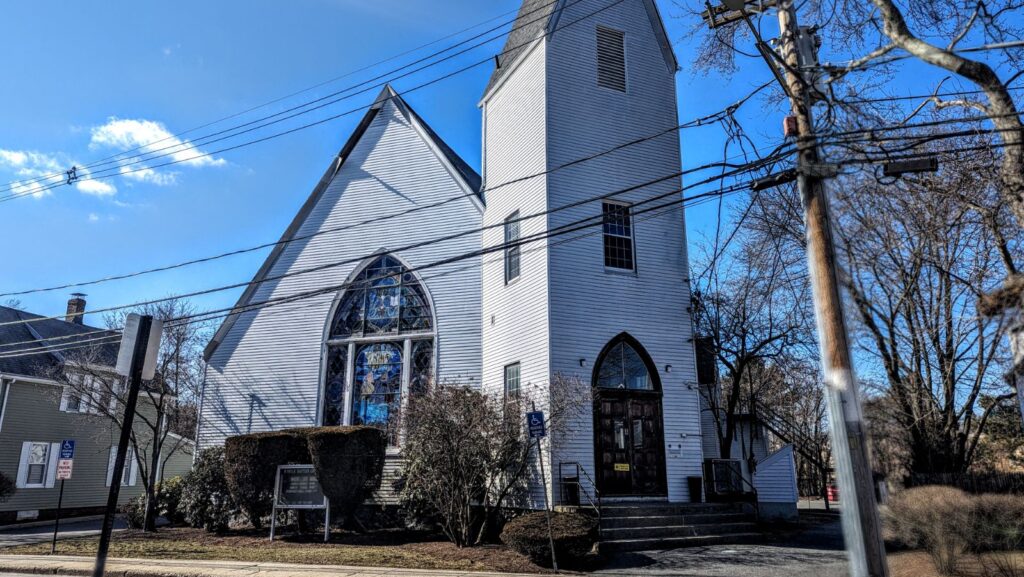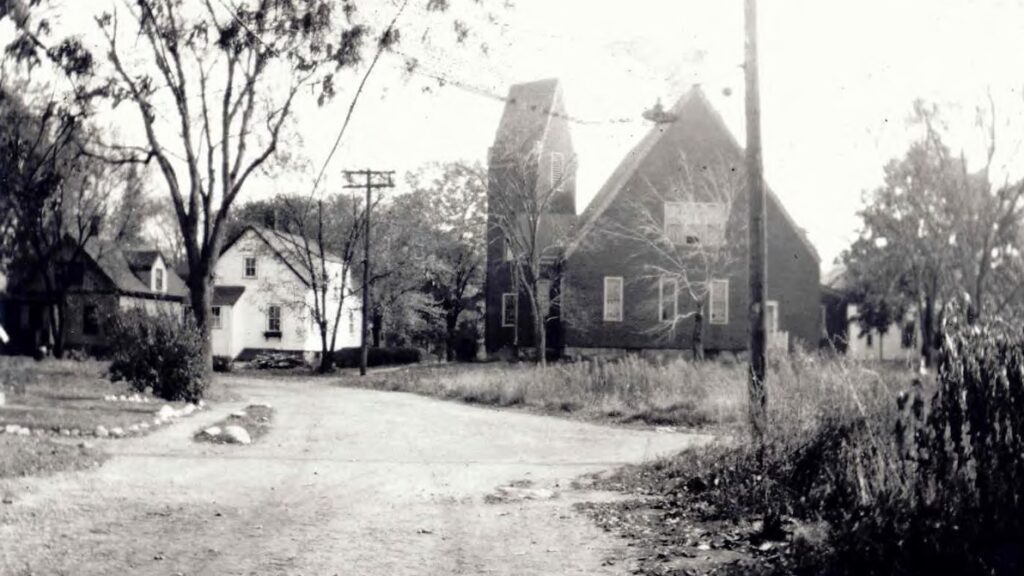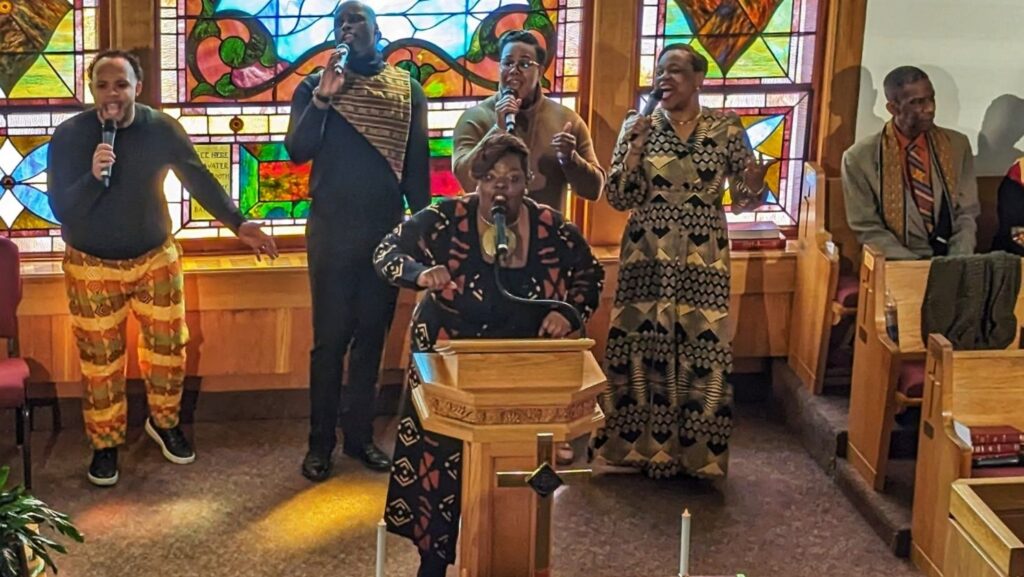Myrtle3
Myrtle Baptist Church Pastor Brandon Thomas Crowley delivers a sermon at the church's annual African American Heritage Sunday service. Photo by Bryan McGonigle
In October 1874, a group of Black families established a church in West Newton to accommodate the city’s growing Black population.
They named that church after the myrtle tree—a small but sturdy flowering tree that keeps its vibrant leaves yearlong—and Myrtle Baptist Church became home for Black families that arrived in Greater Boston in the Great Migration that followed.
“They wanted to worship in their own way,” Senior Pastor Brandon Thomas Crowley said Sunday at the church’s annual African American Heritage Sunday service. “And what you feel in here this morning is our own way.”
That church’s congregation—solid and evergreen as its namesake tree—has survived 150 winters, the Great Depression, two world wars, the influenza pandemic, the COVID-19 pandemic, and the gutting of its neighborhood by the Massachusetts Turnpike Authority.
The story of Myrtle Baptist Church is one of resilience.
A village takes root
In 1865, there were 14 Black residents in Newton. By 1875, that number had spiked to 130, according to a 2010 documentary, “Myrtle Baptist: Pillar of the Community,” by producer (and Newton Beacon board member) Joe Hunter.
Black families were moving to Greater Boston in large numbers, because the area had job opportunities. Newton was a rapidly developing city with rail connections to Boston beginning in the 1830s. And the abolitionist movement was strong in Newton, which was involved with the Underground Railroad.
Many Black people who moved to Newton then were former slaves who carried their certificates of freedom with them everywhere—even after President Abraham Lincoln issued his Emancipation Proclamation and even a few years after the Civil War ended—just in case.
Most settled in West Newton, forming a large Black-majority neighborhood nicknamed “The Village.”
Lincoln Park Baptist Church on Washington Street had a progressive white congregation who welcomed Newton’s Black residents to worship there.
But Black Newton residents wanted their own church, where they could sit in the front pews if they wanted. They started worshipping in each other’s homes and in late 1874 formed their own church and would complete construction on the new church building on Curve Street the following year.
Founding members were Thomas Johnson, Martha Johnson, Limus Hicks, Sarah Simms, Henrietta Rose, Jane Brewer and Henry Jones.
They named the new church Myrtle Baptist after the tree, symbolizing enduring strength and steadfastness.
The church’s first pastor, Edmund Kelley, was born into slavery in 1817 in Tennessee.
“His story is remarkable,” Katy Haywood, church historian, said at Sunday’s service. “Like many other notable Black figures in our history, he taught himself to read. And despite his station in life, he was later ordained by whites as an evangelist in 1843.”
Kelley moved to Boston in 1847 but had to leave his wife and children behind, because they were still enslaved. Kelley worked in New Bedford to raise money to purchase his wife and children, and the family was reunited in 1851.
Kelley would later serve as pastor in various small churches before visiting West Newton and helping to found Myrtle Baptist Church.
There was pushback from white abolitionists, including famous education pioneer Nathaniel Topliff Allen, who wanted Black residents to continue to worship in the same church as them.
A village branches and grows
And that congregation would grow and flower like the myrtle in May. By 1900, Newton had one of the highest populations of Black residents in the northeastern United States, and the Village grew to encompass six streets— Prospect Street, Curve Street, Hicks Street, Douglas Street, Simms Court and Virginia Road—becoming home to dozens of families.

The Village even had its own baseball team, the West Newton Colored Giants, consisting of men from the Village.
“It was as important to us as the Boston Red Sox are today,” Sam Turner, longtime Newton educator and member of Myrtle Baptist Church, says in Hunter’s documentary.
The Colored Giants played at the West Newton Common near West Newton Square and every game was a big neighborhood event.
“There were a couple of players who could have, if they had been able to play professional baseball then, would have been drafted because they were that good,” Turner adds.
A village in ashes
In 1897, the church burned down. Newspaper reports say the fire started at 2:20 a.m. on a Thursday morning, Sept. 24, and caused $900 in damages (which amounts to tens of thousands of dollars today) to the building and the contents inside.
There was a fundraising effort that followed. A local newspaper appeal urged readers to “give as liberally as they can.”
In September 1898, a year after the church fire, the cornerstone was placed for the new building in its place—a building that stands proudly on Curve Street today.
A village run over
What was taken from Myrtle Baptist several decades later, however, was irreplaceable.
In the 1950s, the newly created Massachusetts Turnpike Authority, chaired by Newton resident William F. Callahan, was tasked with connecting Western Massachusetts to Boston via I-90, with an extension from Route 128 to Boston.
In 1962, Callahan decided to run the extension alongside the Boston and Albany railroad tracks, which cut through several neighborhoods, including the Village. Granted a lot of authority and armed with eminent domain, Callahan ran the Turnpike through West Newton, taking properties that stood in the way.
The construction of the Turnpike extension knocked down a third of the homes in the Village and whole streets—Hicks Street, Douglas Street and Virginia Road—disappeared.
Adding insult to the displacement, the state forced residents and businesses to leave before offering them a non-negotiable price for their property, which was in many cases much less than people needed to start over elsewhere.

“When they decided to come and take the house, they just took the house, and gave you what they thought you should have” Myrtle Baptist member Leahnora T. Hill recalls in the 2010 documentary. “They gave me about what we paid for it. We didn’t have any chance to say, ‘Well we have put a lot of equity in this house and should have more.’ We didn’t get that chance.”
Racist housing practices made things worse for families displaced from The Village. Barbara Cooper, former Village resident displaced by the Turnpike, says in the documentary that she went to real estate agents all along Washington Street.
“Some would get start getting flushed in the neck and get pink and red and carry on because they didn’t know how to deal with an African Americans, I guess,” Cooper says. “And if they did. They tried to show you something that their little dog wouldn’t live in.”
Cooper eventually found a home in Newton, but even when buying that house she was met with apprehensive neighbors and the real estate agent tried to get her to look elsewhere. She persisted, though, and got the house.
A village is evergreen
Today, members can attend virtually so even family members who moved away after the Turnpike went in and people who want to attend but can’t make it in person can still be part of the Myrtle family.
The Daughters of Myrtle is an organization run by Myrtle Baptist Church women since 1921 that helps girls and young women thrive. One of those young women was Dr. Deidre Hill Butler, an author and sociologist who was guest speaker at Sunday’s service.
“With the Daughters of Myrtle, I learned so much about being innovative and creative with the talents and skills that each woman brought,” Butler said. “And then they would bring their daughters, and there was like a whole generational transfer and connection that still endeavors today.”
And across the street from the church is Myrtle Village, a seven-unit affordable housing complex built in 2017.

Behind the Myrtle Baptist Church building on Curve Street is a large wooden sound barrier wall that stretches the length of the Turnpike, a symbol of what the state took from the Black community of Newton.
But the church itself is a symbol, too. With roots deep and branches high, that church has stood tall through 150 years of change, struggle and growth. The story of Myrtle Baptist Church is indeed one of resilience. It’s a village where there was isolation. It’s a song where there was struggle. It’s a home that has refused to leave its members even when they were forced to leave their neighborhood.
“May our history sustain us as we go into the highways and the byways of a world that disdains our Blackness,” Pastor Crowley prayed passionately to the congregation at the close of Sunday’s service. “I pray that the charge that we’ve received in this space will help us to remember who we are in a world that tries to force us to deny who we are.”
Myrtle Baptist Church will mark its 150th anniversary later this year and is collecting donations to help fund the celebrations.
To learn more about Myrtle Baptist Church, visit the church website which has a section on its history, its community efforts and ways to get involved.
To learn more about the documentary, “Myrtle Baptist: Pillar of the Community,” contact Historic Newton.